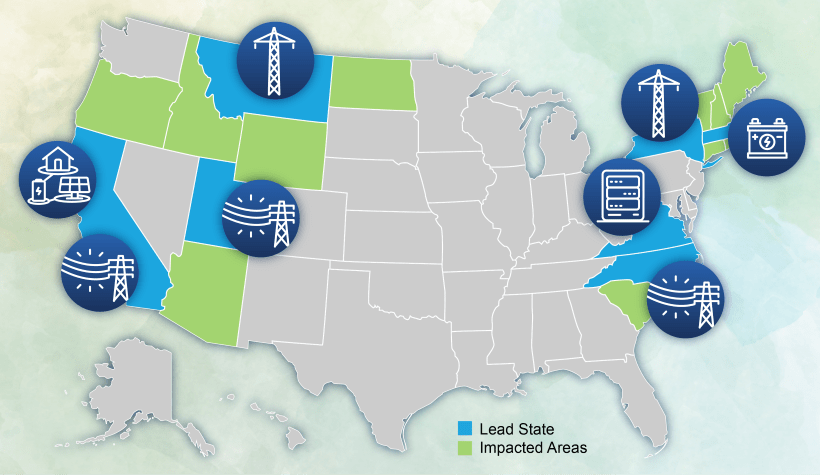By guest contributor Surj Patel – The year 2020 brought us unprecedented challenges from COVID-19, record-breaking wildfires across the west, civil and social unrest and a hotly contested national election. With the transition to a new Biden administration coming in view, Grid Forward and more than 130 leaders in electrical power and the grid came together to talk about what impacts the new administration may have on the electric utility sector and grid modernization in particular.
A central theme from among the speakers was optimism with the new administration and that past bi-partisan mis-alignments may be corrected. Compounding this change is that fact that the 117th Congress represents “a sea change” and “musical chairs” at both the federal and state level for key energy influencers as new faces enter key positions. The Town Hall speakers indicated that we all can assist this transition by educating key decision makers on infrastructure issues from our perspectives.
While Federal programs continue to seek direction, it will be especially impactful for members to continue to work at the state level to keep regional efforts moving ahead. While a number of grid innovation needs remain in the mix, the first order of business collectively is extending COVID- 19 assistance packages for the entire country, as well impacted elements of the electric industry, to heal from health and economic impacts.
During the conversation three themes stood out:
- We need increased investment in infrastructure. The current infrastructure needs investment before we can bring online the renewable sources that are needed to reach decarbonization goals, maintain cost effective delivery, and increase resiliency in the face of a rapidly evolving landscape of threats.
- Siting is a problem that NEEDS to be resolved. As more renewable energy sources come online these resources need to be delivered efficiently to grid loads. Many advocated for the need to re-invigorate and realign what has been mandated by the outgoing administration. The new administration looks favorable on positive progress on long-desired solutions for siting both generation and transmission infrastructure. Finding solutions together with the industry and many stakeholders can lead to a good common ground for progress.
- Innovation must meet short-term needs and long-term goals. After the ravages of 2020 – from customer impacts during a global pandemic to historic wildfire damage – we need to roll out many innovative practices and solutions for grid modernization. At the same time, we need to invest in advanced technology now to achieve numerous regional decarbonization commitments. While some of that funding comes from industry, government and other parties play critical roles to build ROI cases for new funding initiatives. Grid Forward members can help by informing, educating and supporting state level efforts that feed into the federal decision making process.

The session was marked by these other notable points:
- The public cloud can be a common platform for the modern grid and it’s already built. The tech industry is “leaning in” and saying that the public cloud provides a present and ready solution to power the backbone of smart grid applications. FERC 2222 and other initiatives are opening up markets and welcoming new players.
- AI and big data will provide the “decision infrastructure” for reducing costs immediately and finding long term synergistic savings. In the future there is an opportunity to “converge” better decision-making between oil and gas supermajors and renewable energy providers through a shared information platform.
- Grid modernization can address wildfire risks if we can receive proposed funding for R&D initiatives in wildfire mitigation. This area presents a ripe opportunity for lesson sharing and bridging research conducted by industry organizations (like EPRI and EEI) and national lab resources
- The U.S. Senate has a short window for trying to pass packages. The bi-partisan Senate energy package pushed forward by Sen. Murkowski might progress before the end of this Congress, but no guarantees. Sections concerning modernization and storage enjoy a lot of support but moving ahead with the full package (via conference with House package) remains a question. If not, how the package moves ahead in the next congress remains a question due to important leadership changes.
- Grid vulnerability and cyber security are two major innovation and deployment issues that are gaining support at federal and state levels and will be crucial to any long term grid and infrastructure success.
- Educating regulators to think about resource adequacy, resilience, and infrastructure priorities is an important area now, and only becoming more vital.
- Community service developments around distributed generation provide a great area for innovation to provide immediate social benefit.
- Siting advancement will require building more trust between Capitol hill, industry, non-profits, and other stakeholders so that industry is better able to meet identified needs
- Capital is available in our industry for transmission upgrades and key infrastructure efforts but our industry needs better clarity on ROI and incentives to move these areas ahead
- Distributed resource initiatives and self generation will require a common “System Visibility Infrastructure” to scale and succeed at a national level.
With nine speakers over 90 minutes we managed to cover alot of ground. If you are interested in specific federal bills, congressional office relationships, or developments at key agencies where Grid Forward and our members are engaging, feel welcome to reach out and we’d be happy to collaborate with you. We hope that you will be able to join us in the future as we collaborate to move our industry forward and build a smarter and more resilient infrastructure to meet the dynamic issues on our grid.
- Author: Surj Patel is a Portland, OR-based technologist, media executive and self-described “Power Nerd” who is very enamored with open DC nanogrids and a modernized smart grid, and embraces the opportunities created by FERC 2222.



